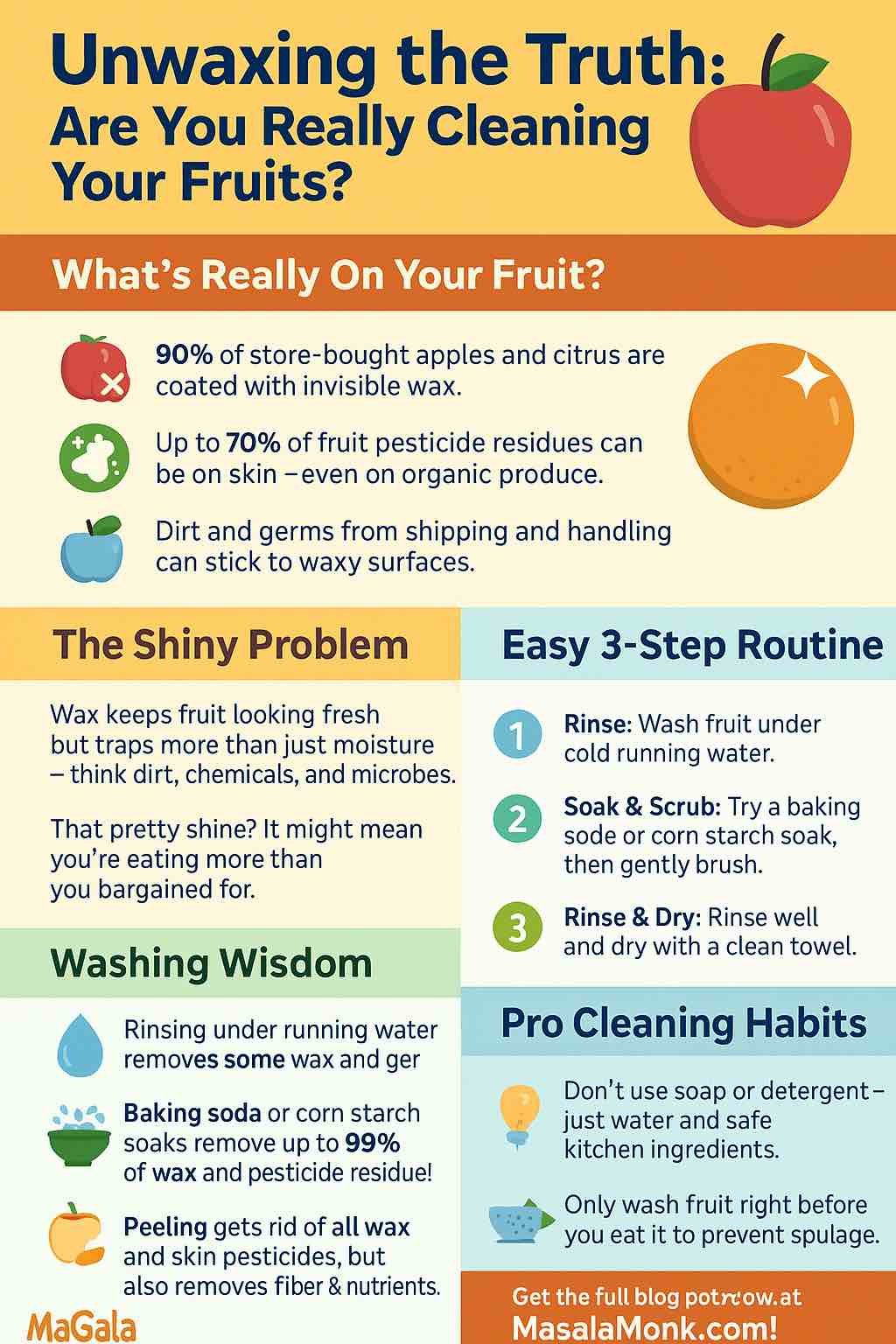
Have you ever noticed how apples at the store seem to glisten? Or how oranges sometimes feel a little slippery, even after a rinse? That’s fruit wax—a perfectly legal, food-safe coating used to keep produce looking fresh and to slow down spoilage. But is it something you want to eat? And, more importantly, are you really getting rid of wax, dirt, and pesticides when you wash your fruit?
Let’s get into the practical steps and science behind cleaning your fruit—no hype, just what works.
What’s On Your Fruit?
- Wax is added after harvest to help fruit last longer and look appealing. It forms a thin layer over the skin.
- Pesticide residues can be found on (and sometimes inside) both conventional and organic produce.
- Dirt and germs from handling and transport are also present—even on organic or homegrown fruit.
Key insight: Most of the time, wax and surface pesticides can be removed with a smart cleaning routine. But for some deep-penetrating chemicals, only peeling fully removes them.
The Smart Routine: Clean Fruit, Less Fuss
Here’s how you can actually get rid of most wax, dirt, and pesticides at home, with everyday ingredients.
1. Don’t skip the rinse
Before anything else, rinse your fruit under cold, running water. Use your hands to gently rub the surface. This alone removes a lot of dirt and some microbes.
2. Make a cleaning solution (optional, but very effective)
For an extra-clean feeling, especially with apples, pears, cucumbers, or anything with a waxy finish:
- Corn Starch Soak:
Mix 2 teaspoons of corn starch in 1 cup of water. Soak your fruit for about 10 minutes. - Baking Soda Soak:
Afterwards, mix 2 teaspoons of baking soda in 1 cup of water. Soak for another 10 minutes. - For quick results, you can also just scrub with a little baking soda paste (baking soda + a splash of water) on a damp cloth.
3. Scrub if you can
Firm fruits (apples, cucumbers, citrus) benefit from a gentle scrub with a clean brush. This helps lift wax and dirt. For softer fruit (plums, peaches), rub gently with your hands.
4. Rinse again
Always rinse fruit thoroughly under running water after any soak or scrub, to wash away loosened wax and residue.
5. Dry with a clean towel
This step removes even more wax and helps keep your fruit from spoiling too fast. If you’re prepping fruit for storage, skip washing until you’re ready to eat.
6. Peel if needed
If you’re serving fruit to young kids, pregnant women, or anyone with a weakened immune system—and you’re worried about possible pesticide residues—peeling is the ultimate way to remove what’s left. Just remember, you lose some fiber and nutrients in the skin.
For Specific Fruits
- Berries and grapes:
Don’t use scrubs or soaks. Just rinse thoroughly in a colander right before eating. Too much soaking causes them to break down. - Leafy produce (like apples, cucumbers, citrus):
The corn starch and baking soda method works best. - Stone fruit (peaches, nectarines):
Gentle rubbing and a quick baking soda soak help if the skin feels slick or sticky.
Pro Cleaning Habits
- Wash fruit right before you eat it. Washing and storing adds moisture and speeds up spoilage.
- Don’t use soap or dish detergent. These aren’t meant for eating and can leave behind their own residues.
- Even organic fruit needs a rinse. “Organic” doesn’t mean “clean.”
Final Word
You don’t need fancy produce washes or special gadgets. Cold water and a little time are the best start; baking soda or corn starch solutions are your next-level upgrades for waxy or heavily handled fruits. If you want total peace of mind, peel—otherwise, just rinse, scrub, and enjoy. Every bite is better when it’s clean!
Try this routine next time you prep fruit and see the difference. If you notice a residue come off, or the fruit’s shine dull, you’re actually seeing the wax and dirt go down the drain—right where they belong.
Frequently Asked Questions (FAQs)
1. Do I really need to wash fruit if I’m going to peel it anyway?
Yes. Washing removes dirt, bacteria, and pesticides from the surface. If you peel unwashed fruit, your knife can transfer residues from the skin to the flesh.
2. Can I use dish soap or hand soap to clean fruit?
No. Soaps can leave behind residues that aren’t safe to eat and aren’t approved for use on foods.
3. Does vinegar actually remove pesticides?
Vinegar can help reduce some surface bacteria and wax, but baking soda or the corn starch method are more effective for removing pesticides.
4. Is it safe to eat the wax on store-bought fruit?
Yes, most commercial waxes are food-grade and considered safe. However, washing can remove dirt and any trapped residues under the wax.
5. How do I clean delicate fruits like berries or grapes?
Rinse gently under cold, running water right before eating. Avoid soaking for long periods, as this can make them mushy.
6. Does organic fruit need to be washed too?
Yes. Organic fruits can still have dirt, bacteria, and natural residues, so always wash them before eating.
7. What’s the best way to wash leafy greens or herbs?
Swish them in a bowl of cold water, let dirt settle, lift out, and rinse under running water. Repeat if necessary.
8. Can I use commercial fruit and veggie washes?
Most health experts say they aren’t necessary—plain water or homemade solutions (like baking soda) work just as well and are safer.
9. Why should I avoid washing fruit before storing it?
Moisture left on fruit encourages mold and spoilage. Always wash fruit just before eating or using it.
10. What’s the fastest way to remove wax from apples and cucumbers?
A quick scrub with a baking soda paste (baking soda + a little water) and a brush, followed by a thorough rinse, removes most wax quickly.









